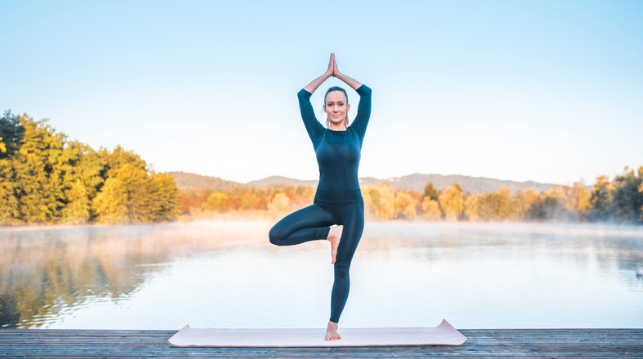Vrikshasana (Tree pose): How to Practice, Its Benefits and Precautions
Vrikshasana, commonly known as Tree Pose, is a standing balance pose that emulates the graceful, steady stance of a tree. The pose’s name comes from the Sanskrit words “Vriksha,” meaning tree, and “asana,” meaning posture. Unlike Tadasana (Palm Tree Pose), which also focuses on balance and alignment but with both feet grounded, Vrikshasana challenges the practitioner to balance on one leg, promoting concentration, balance, and poise.
Origin of Vrikshasana (Tree Pose)
Vrikshasana is a staple in many yoga practices today, but its origins trace back to the ancient need for meditative focus and physical stability in yogic practice. While Tadasana serves as a foundational pose meant to instill alertness and align the body vertically like a stretching tree, Vrikshasana introduces an element of balance that requires both physical and mental steadiness, mimicking a tree that stands firm against many elements.
Detailed Instructions and Body Alignment
Starting Position:
Begin in Tadasana. Ground your feet, spread your toes, and ensure your weight is evenly distributed. Engage your core and find a point of focus for your gaze to aid in balance.
Steps:
- Carefully shift your weight onto your left foot, keeping the inner foot firm to the ground.
- Bend your right knee, and place your right foot on the inner left thigh, toes pointing downward. The heel should be as close to the pelvis as possible. Avoid placing the foot against the knee.
- Once balanced, bring your palms together in prayer position at your heart center. Ensure your pelvis is neutral, and your standing leg is straight but not locked.
- Inhale and extend your arms above your head, keeping the palms pressed together or separate them, reaching like branches toward the sky.
- Hold the pose for 30 seconds to one minute. Breathe steadily; focus on maintaining a steady balance.
- Exhale and gently release your arms and leg back to Tadasana.
- Repeat on the opposite leg.
Check Out Yoga in Rishikesh
Alignment Tips:
- Keep your gaze fixed on a point in front of you to maintain balance.
- Engage the abdominal muscles to stabilize the core.
- Ensure the pelvis is neither tilting forward nor backward.
Benefits of Vrikshasana (Tree pose)
Vrikshasana strengthens the thighs, calves, ankles, and spine while stretching the groins and inner thighs, chest, and shoulders. It improves sense of balance, provides neuromuscular coordination, and builds self-confidence and esteem. This pose is also therapeutic for sciatica and reduces flat feet.
Contraindications
Avoid Vrikshasana if you suffer from migraine, insomnia, low or high blood pressure. Those with recent hip replacements should not attempt this pose. Always perform under expert guidance if you have balance issues or are prone to dizziness.
Differentiation from Tadasana
While both poses promote stability and balance, the key difference lies in their execution. Tadasana involves standing with feet together, hands at the sides, and the body evenly aligned, serving as a preparatory or transitional posture. Vrikshasana, however, challenges balance by requiring the body to stabilize on one leg, which promotes not only physical but also mental concentration and meditation.
To summarize
Vrikshasana, or Tree Pose, is a reflective and stabilizing posture that embodies the strength, balance, and grace of a tree. Unlike the grounded stability of Tadasana, Tree Pose offers a unique challenge that combines physical poise with mental focus. Regular practice of this asana can lead to profound improvements in balance, focus, and overall well-being, making it a valuable addition to any yoga practice.
Learn to know more about Vrikshasana so you can join 200 hour yoga teacher training in India and kundalini yoga teacher training in India and yin yoga teacher training in india



